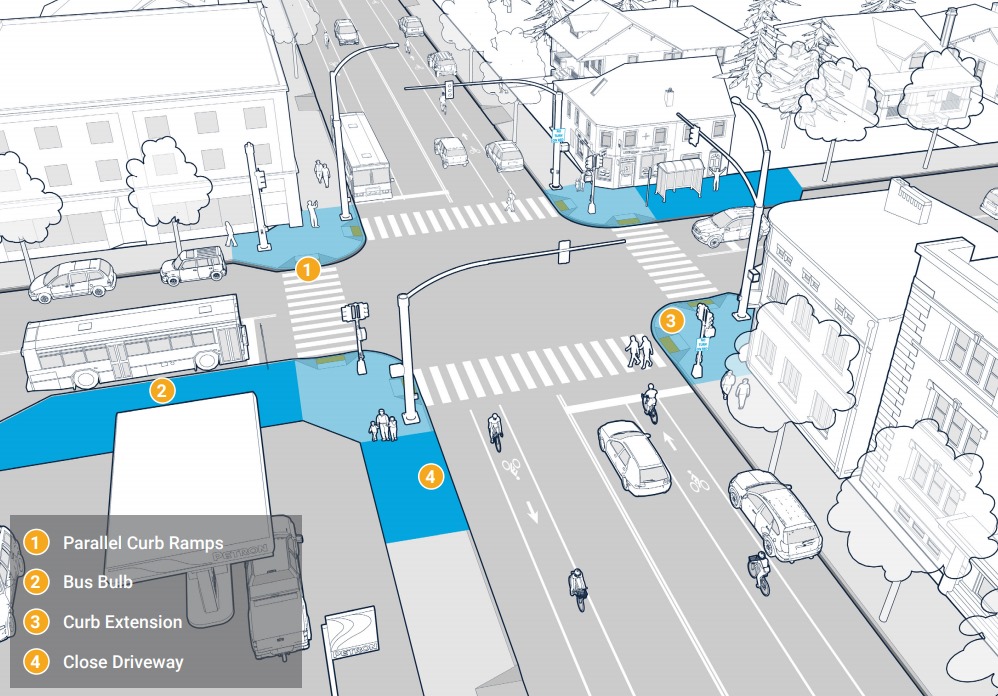Committee Okays City Pedestrian Plan
98 pages with 100 actions suggested. But will any of it be funded?

Conceptual high impact redesign of N. 27th St. and W. Burleigh St. intersection in Milwaukee Pedestrian Plan.
A Milwaukee Common Council committee has approved a 98-page pedestrian plan intended to provide a toolbox for making the city more walkable, but a bigger question remains over what resources the city can commit to implementing the 20 recommendations.
Approximately five percent of residents commute to work on foot on the city’s 1,424 miles of paved streets, but every resident is at one point or another a pedestrian according to the report.
“We have some positives in that over the past 20 years. We have seen pedestrian-related crashes go down, cut almost in half,” said Department of Public Works (DPW) bicycle and pedestrian coordinator James Hannig. “Unfortunately in the past 20 years, we have seen an increase in the severity.”
“The number one contributor to pedestrian safety is speed,” Hannig told the Public Works Committee. “While Milwaukee overall has a fairly solid network of sidewalks, we know there are gaps in that network.” He showed a graphic illustrating that a car traveling 20 miles per hour has a 13 percent chance of causing a severe injury in a collision with a pedestrian while a car traveling 40 miles per hour has a 73 percent chance of causing severe harm.
“Roughly a third of the actions in the plan are already underway,” said DPW multi-modal transportation planning manager Michael Amsden.
The second half of the plan includes a series of illustrations showing how new crosswalks and street redesigns could improve things for pedestrians.
But while the plan’s features drew support from the committee, multiple council members raised concerns about paying for things as simple as sidewalk replacement.
“One of the things that I think would have the biggest improvement on people walking around is replacing sidewalks,” said Alderman Michael Murphy. “Is there a proposal for increased sidewalk replacement in this year’s budget?”
“Not at that this point,” said Amsden, while noting the longterm vision is to do so.
“I’m a little frustrated that we say we support this, but we don’t put any money behind it to increase the safety of our citizens,” said Murphy. “You did a very good plan, I’m not disagreeing with that, but if you don’t put money behind it it just gets put on a shelf somewhere.”
Jake Newborn of the Wisconsin Bicycle Federation testified in favor of the plan, but said funding was needed.
Committee chair Ald. Robert Bauman quickly fired back. “Don’t just tell us, with all due respect, to add money. Tell us what you want to see cut.”
“It’s kind of a zero-sum game,” said Bauman of the city’s $1.5 billion annual budget. “If we add that money it has come from another program. We can’t increase money coming into the city.” The state has imposed a property tax cap on municipalities.
Bauman said that Black Leaders Organizing for Communities (BLOC), led by Angela Lang, has been meeting with council members and asking for a $25 million reduction in the $300 million Milwaukee Police Department budget. The funds would be used to address the root causes of poverty.
Ald. Nik Kovac said the request had the potential to change the conversation internally. “It certainly gets the ideas flowing,” said the alderman.
“We really do need advice from community advocates,” said Bauman to Newborn. “I basically agree with your position.”
Murphy suggested Hannig and Amsden also explore state and federal grants, something the plan suggests.
The DPW representatives promised to give Newborn and others a list of costs for various projects from building protected bike lanes to painting crosswalks.
The committee unanimously approved the plan.
For more on the plan, listen to our February podcast with Hannig and Amsden.
If you think stories like this are important, become a member of Urban Milwaukee and help support real independent journalism. Plus you get some cool added benefits, all detailed here.
Legislation Link - Urban Milwaukee members see direct links to legislation mentioned in this article. Join today
Related Legislation: File 190535
Political Contributions Tracker
Displaying political contributions between people mentioned in this story. Learn more.
Transportation
-
MCTS Adds 28 New Buses
 Jul 13th, 2024 by Graham Kilmer
Jul 13th, 2024 by Graham Kilmer
-
MCTS Designing New Bus Shelters
 Jul 10th, 2024 by Graham Kilmer
Jul 10th, 2024 by Graham Kilmer
-
MCTS Updates RNC Bus Detours To Better Serve Downtown, Riders
 Jul 9th, 2024 by Jeramey Jannene
Jul 9th, 2024 by Jeramey Jannene






















Crazy idea, but low cost, would be making the cross-walk stripping twice as wide, putting cars further away from the crossing and making the intersection more visually pedestrian friendly.